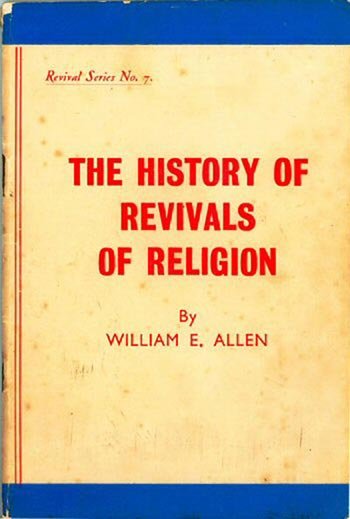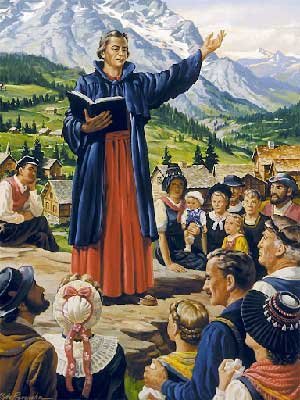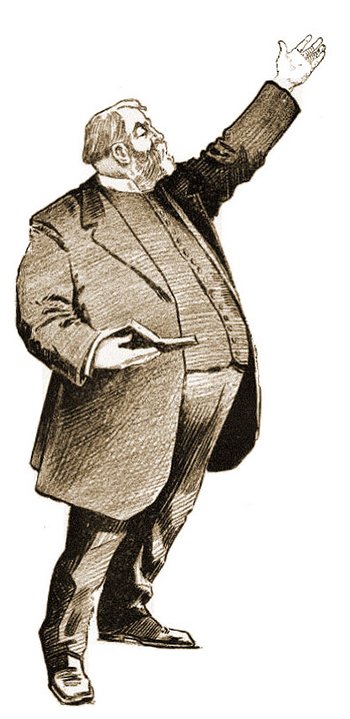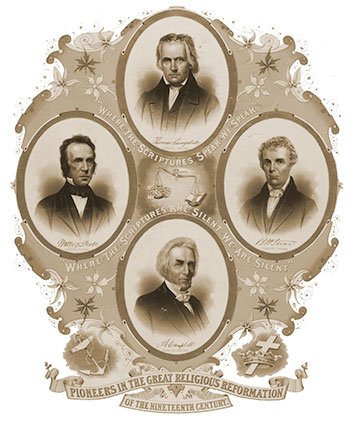Pre-Reformation Revivals
William E. Allen

William Allen’s History of Revivals of Religion
This article is the first chapter of a small booklet- just 82 pages – entitled The History of Revivals of Religion by William E. Allen. It is an ideal primer for new students of revival, briefly covering all the major revivals through to the mid-20th century.
Pre-Reformation Revivals in The Early British Church
Gildas the wise, a Welsh monk, writing about 500 A.D. said, “The Church is spread over the nation. It had spread, moreover, into Ireland and Scotland. It was also a learned Church; it had its own version of the Bible and its own ritual.
St. Patrick (395-493) became the Apostle of Ireland. He said, “I was re-formed by the Lord, and He hath fitted me for being at this day what was once far enough from me, that I should concern myself for the salvation of others, when I used not to think even of my own.’’ For about thirty years St. Patrick preached the Gospel throughout Ireland, and established churches, monasteries, and schools from which missionaries were sent forth for four centuries after his death. A few lines from his famous “Breastplate” hymn—which he composed at Tara on the eve of his historic interview with King Leogaire—reveal the spirit of the man and the Gospel he preached.
“Christ as a light, illumine and guide me!
Christ as a shield, o’ershadow and cover me!
Christ be under me, Christ be over me!
Christ be beside me on the left hand and right!
Christ be before me, behind me, about me!
Christ this day be within and without me!”
“Salvation dwells with the Lord, with Christ the omnipotent Word,
From generation to generation—grant us, O Lord, Thy grace and salvation.”
From Ireland Columba went to lona and established a church and monastery. During the following years he and his associates founded churches, monasteries, and schools from the Orkneys and Hebrides south to the Humber.
The mission of Augustin and his successors in the sees of Canterbury and York so limited the field of the Irish and Scotch missionaries at home, that they “swarmed like bees into the dark places of heathen Europe.” Ireland was called “the Isle of Saints,” the “University of the West.” Copies of the Bible marked with commentaries in Irish to the Teutonic, Scandinavian, and Italian peoples are still extant.
Some of the leading Missionaries to Europe were: Columbanus, St. Gall, Kilian, Virgilius, Fridolin, and Willibrord. Thirteen monasteries were founded by the Irish in Scotland, twelve in England, seven in France, twelve in Brittany, seven in Lorraine, ten in Alsatia, sixteen in Bavaria, fifteen in Rhetia, Helvetia, and Allemania; also many in Thuringia and on the left bank of the Lower Rhine; and six in Italy.
Of saints of Irish origin who are recognised as the patrons or founders of churches, there were a hundred and fifty in Germany, forty five in Gaul, thirty in Belgium, thirteen in Italy, and eight in Norway and Iceland.
This purely British Church maintained its independence until 1172, when the Synod of Cashel bound it to the Romanised Church in England.
Waldenses Revival 1184

A Waldenses outdoor meeting
The story of the faithfulness, endurance, and heroism of the Waldenses down the centuries is unique in Church History. Where they live “there is not a rock that is not a monument, not a meadow that has not seen an execution, not a village that does not register its martyrs.” In the twelfth century they experienced a revival which resulted in great evangelistic activity.
This movement was led by Peter Waldo. All were missionaries, and preached in the houses, streets, and market places. Rev. Clarke says of them, “ The sect spread with extraordinary rapidity, and extended from Arragon to Ponierania and Bohemia, though most numerous in the south of Frances Alsace, and in the mountain districts of Savoy, Switzerland and Northern Italy.”
Bohemian Revival 1315
In 1315 it was reckoned that there were 80,000 true Christians in Bohemia alone. This remarkable spiritual revival was partly the result of the labours of three reformers, Conrad of Waidhausen, Milic of Moravia, and Matthias of Janow; it prepared the way for the movement that was led by John Huss.
In 1467 some Bohemians, Waldenses, and Moravians united in what was known as the Unitas Fratrum Church. When the Reformation dawned they had four hundred churches, and were circulating their own Bohemian Bible. This persecuted remnant of the followers of Huss continued until 1715 when Christian David led a company of them into Saxon Silesia where they settled on the estate of Count Zinzendorf.
John Wickliffe 1320s-1384
In the 14th century Wickliffe reopened the Bible, and began to expose the errors of the Roman Church. Many were converted through his preaching and writings. He also founded an association of preachers called Lollards, and sent them to preach up and down the country.
Wickcliffe was a man of prayer, and the reforms he advocated were the result of his own spiritual enlightenment through reading the Bible. He declared, “The sacred Scriptures are the property of the people, and one which no one should be allowed to wrest from them. Christ and His apostles converted the world by making known the Scriptures, and I pray with all my heart that through doing the things contained in this book, we may all together come to the everlasting life.”
John Huss embraced the doctrines of Wickliffe, and after exerting a mighty influence for the Gospel inBohemia, he was martyred in 1415.
Savonarola 1452-1492
After listening to a sermon from an Augustinian friar, Savonarola at the age of twenty-three decided to adopt the monastic life. He became famous as a preacher in the Lent of 1489, and shortly afterwards he was elected Prior of St. Mark’s Convent, Florence.
Villari says, “Wonderful was the effect of Savonarola’s preaching on the corrupt and pagan society of Florence. His natural, spontaneous heart stirring eloquence, with its exalted imagery and outbursts of righteous indignation, was entirely unprecedented in that era of pedantry and the simulation of the classic oratory.
The Prior’s preaching confounded his foes, for it completely changed the aspect of the city. The women cast off their jewels and dressed simply; young profligates were transformed into sober, religious men, the churches were filled with people at prayer, and the Bible was diligently read.
The fame of this marvellous preacher was now extending throughout the world by means of his printed sermons. Even the Sultan of Turkey commanded them to be translated into Turkish for his own study. Of course, the individual aim of Savonarola was simply to be the regenerator of religion.” As one of the first Protestants, and as a herald of the Reformation, Savonarola soon got into trouble with the Pope, and as a result he was executed in 1498.
The Reformation 1517 on
Under the Roman Church millions of souls lived in continual fear of the wrath to come. No doubt their cry came up before God and He came down to deliver them.
Through bitter experience Martin Luther knew the spiritual agonies of the people, and the failure of any good works to give assurance of salvation. Then he began to read the Bible, and slowly the truth of Justification by Faith dawned upon his soul.
It is wonderful to follow the growth of Luther’s work. The Reformation burned in his heart. He was possessed with divine strength and wisdom, as he met each difficult situation.
Luther prayed hours every day. Once a spy followed him to a hotel. The next day he told his employer that Luther had prayed nearly all night, and that he could never conquer one who prayed like that.
One day Luther was told that Melancthon was dying. He hurried to see him, and aroused him from his stupor. Melancthon looked at him and said, ”O Luther, is this you? Why don’t you let me depart in peace?” “We can’t spare you yet, Philip,” replied Luther; and turning round, he went upon his knees, and wrestled with God for his recovery. From that time Melancthon recovered. Luther said, “God gave me back my brother Melancthon in direct answer to prayer.”
Luther knew what it was to travail in prayer, to wrestle with the powers of darkness that engulfed the whole world. Listen to him in an agony of prayer in the morning of the day when he had to make his defence before the Diet of Worms.
“O Almighty and Everlasting God! How terrible is this world! How weak is the flesh, and how powerful is Satan! O God! O God! O God! Do Thou help me against all the wisdom of the world! For this is not my work, but Thine. The cause is Thine, and it is a righteous and eternal cause. O Lord! Help me! Faithful and unchangeable God! Thou hast chosen me for this work. I know it well! Act, then, O God, stand at my side, for the sake of Thy well-beloved Jesus Christ. Amen.”
God answered this prayer immediately, and filled Luther with such strength and wisdom that he won that day the greatest victory in the history of the Reformation.
The Reformation soon spread over Germany, France, Switzerland, Holland, Denmark, Poland, Sweden, and the British Isles. But behind this mighty movement we must remember there were the agonising prayers of millions of hearts; much preaching of the Gospel doctrines; and through the invention of printing, a wide distribution of the Scriptures.
John Calvin 1509-1564
Through reading the Bible John Calvin became a wholehearted follower of the Reformed faith, and before long he was a leader of the Protestants in Paris. In 1536 he published “The Institutes of the Christian Religion,” which was the first complete outline and vindication of Protestantism.
The citizens of Geneva asked Calvin to come and help them in 1541, and for over twenty years he laboured to make Geneva a city of God. Attendance at public worship became compulsory. Wearing gay clothes, and dancing, were punishable offences; marriage was regularised; unchastity was punished with death. The taverns and haunts of sin vanished. A good education became available to all. The churches were crowded, and Geneva became a fountain-head of Protestant inspiration to all Europe.
John Knox 1514-1572
John Knox the Scottish Reformer was a mighty man of prayer. Here is an example of how he prayed, “O Lord, give me Scotland, or I die !” After a time of stillness, again the cry, “O Lord, give me Scotland, or I die !” Once more deep silence. Then again the cry with more intense pathos, “O Lord, give me Scotland, or I die.” God gave him Scotland.
If ever the man and the hour struck together it was when John Knox landed in Scotland in 1559, and commenced his history-changing tour preaching “root and branch reform.” His trumpet-like call sounded over mountain and moor, and ithin a few weeks the chief centres of Scotland were won for the Protestant faith.
Stewarton Revival 1625-1630
This revival began in 1625, and continued for some years. Closely following was the revival at Kirk of Shotts in June, 1630. Here a large number of godly persons gathered for several days of prayer, and conference. At least one whole night was spent in prayer, and when John Livingstone preached, about five hundred persons were converted.
Ulster Revival 1625
This remarkable revival was promoted by a band of faithful ministers. They went forth in companies to evangelise the land, and God used them mightily. There was much prayer and faithful preaching in this revival.
A contemporary description of one of these ministers can be taken as typical of them all. “He was a man of notable constitution, both of body and mind; of a majestic, awful, yet affable and amiable countenance and carriage, thoroughly learned, of strong parts, deep invention, solid judgement, and a most public spirit for God. His gift of preaching was such, that seldom could any observe withdrawing of assistance in public, which in others is frequent. He spent many days and nights in prayer, alone and with others, and was vouchsafed great intimacy with God.”
Here is a short description of those happy days, “Preaching and praying were so pleasant, and hearers so eager and greedy, that no day was long enough, nor any room large enough, to answer their strong desires and large expectations.”
Check out these sources:
Waldensians – Wikipedia
Savonarola – Wikipedia
On this site:
Stewarton and Shotts Revivals
Revival at Shotts



